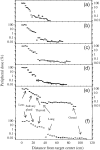Radiation doses with various body weights of phantoms in brain 128-slice MDCT examination
- PMID: 31197311
- PMCID: PMC6640898
- DOI: 10.1093/jrr/rrz029
Radiation doses with various body weights of phantoms in brain 128-slice MDCT examination
Abstract
The effective dose (HE) and organ or tissue equivalent dose (HT) for use in brain computed tomography (CT) examinations with various body weights were evaluated. Thermoluminescent dosimeters (TLD-100H) were inserted into Rando and five anthropomorphic phantoms. These phantoms were made of polymethylmethacrylate (PMMA), according to the specifications of ICRU 48, with masses from 10 to 90 kg. Brain CT examinations were conducted, scanning the maxillae from the external auditory meatus to the parietal bone using a 128-slice multi-detector CT (MDCT) scanner. To reduce errors, three independent trials were conducted. Calculated HE,TLD, based on the weighting factor recommended by ICRP 103, was 1.72 ± 0.28 mSv, which slightly exceeds the HE,DLP of 1.70 mSv, that was calculated from the dose-length product (DLP) of the Rando phantom. This experiment yielded HE,TLD values of ICRP 103 from the highest 1.85 ± 0.28 (90 kg) to the lowest 1.47 ± 0.22 (10 kg) mSv. HE,TLD (mSv) = 5.45×10-3 W(kg) + 1.361, with an R2 of 0.87667. Using the DLP protocol, HE,DLP was estimated from CTDIvol that was recorded directly from the console display of the CT unit and multiplied by the conversion coefficient (k) recommended by the ICRP 103. Finally, the experimental results obtained herein are compared with those in the literature. Physicians should choose and adjust protocols to prevent the exposure of patients to unnecessary radiation, satisfying the as low as reasonably achievable (ALARA) principle. These findings will be valuable to patients, physicians, radiologists and the public.
Keywords: ICRP 103; Rando phantom; computed tomography; effective dose; thermoluminescent dosimeters.
© The Author(s) 2019. Published by Oxford University Press on behalf of The Japan Radiation Research Society and Japanese Society for Radiation Oncology.
Figures





Similar articles
-
Evaluating doses of multi-slice CT in brain examinations using various methods.Comput Assist Surg (Abingdon). 2017 Dec;22(sup1):54-60. doi: 10.1080/24699322.2017.1379136. Epub 2017 Sep 22. Comput Assist Surg (Abingdon). 2017. PMID: 28938858
-
Comparison of Radiation Exposure Associated With Intraoperative Cone-Beam Computed Tomography and Follow-up Multidetector Computed Tomography Angiography for Evaluating Endovascular Aneurysm Repairs.J Endovasc Ther. 2016 Aug;23(4):583-92. doi: 10.1177/1526602816649588. Epub 2016 May 18. J Endovasc Ther. 2016. PMID: 27193306
-
Estimating lung, breast, and effective dose from low-dose lung cancer screening CT exams with tube current modulation across a range of patient sizes.Med Phys. 2018 Oct;45(10):4667-4682. doi: 10.1002/mp.13131. Epub 2018 Sep 24. Med Phys. 2018. PMID: 30118143 Free PMC article.
-
Radiation dose estimation for prospective and retrospective ECG-gated cardiac CT angiography in infants and small children using a 320-MDCT volume scanner.AJR Am J Roentgenol. 2012 Nov;199(5):1129-35. doi: 10.2214/AJR.12.8480. AJR Am J Roentgenol. 2012. PMID: 23096189
-
Techniques and parameters for estimating radiation exposure and dose in cardiac computed tomography.Int J Cardiovasc Imaging. 2005 Feb;21(1):165-76. doi: 10.1007/s10554-004-5338-6. Int J Cardiovasc Imaging. 2005. PMID: 15915949 Review.
Cited by
-
Development of a method to create uniform phantoms for task-based assessment of CT image quality.J Appl Clin Med Phys. 2020 Sep;21(9):201-208. doi: 10.1002/acm2.12974. Epub 2020 Jul 28. J Appl Clin Med Phys. 2020. PMID: 32721106 Free PMC article.
-
Evaluating photoneutron dose equivalents for lung cancer using PMMA phantoms undergoing 15 MV IMRT.Technol Health Care. 2022;30(S1):37-46. doi: 10.3233/THC-228004. Technol Health Care. 2022. PMID: 35124582 Free PMC article.
-
Evaluating dose distributions of normal organs for patients undergoing VMAT therapy of nasopharyngeal carcinoma using Rando phantom and TLD-100H.Technol Health Care. 2022;30(S1):329-336. doi: 10.3233/THC-THC228031. Technol Health Care. 2022. PMID: 35124609 Free PMC article.
-
Effective Dose Measurements of the Latest-Generation Angiographic System in Patients with Acute Stroke: A Comparison with the Newest Multidetector CT Generation.AJNR Am J Neuroradiol. 2022 Nov;43(11):1621-1626. doi: 10.3174/ajnr.A7658. Epub 2022 Oct 6. AJNR Am J Neuroradiol. 2022. PMID: 36202555 Free PMC article.
-
Physical dosimetry reconstructions of significant radiation exposure at an industrial accelerator facility in Tianjin (China).J Radiat Res. 2020 Jan 23;61(1):82-89. doi: 10.1093/jrr/rrz072. J Radiat Res. 2020. PMID: 31821503 Free PMC article.
References
-
- Statistics of General Health Welfare of 2019, Ministry of Health and Welfare, 2019. (https://dep.mohw.gov.tw/DOS/mp-113.html)
-
- Chen TR, Tyan YS, Teng PS et al. . Population dose from medical exposure in Taiwan for 2008. Med Phys 2011;38:3139–48. - PubMed
-
- Brady Z, Cain TM, Johnston PN. Differences in using the International Commission on Radiological Protection’s publications 60 and 103 for determining effective dose in pediatric CT examinations. Radiat Meas 2011;46:2031–4.
MeSH terms
LinkOut - more resources
Full Text Sources
Medical

